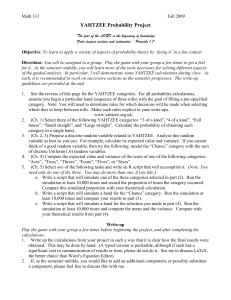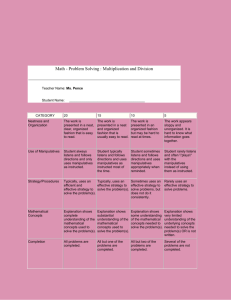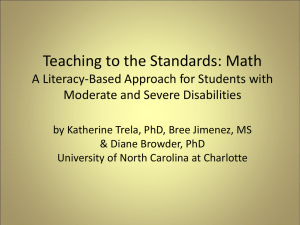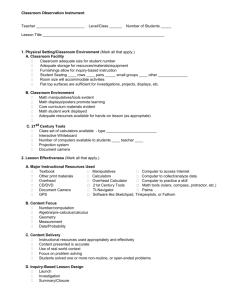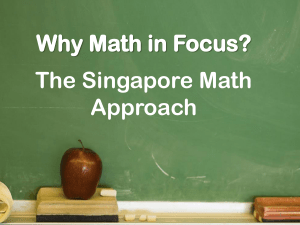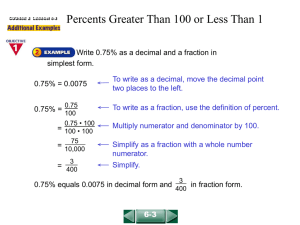Instructional Plan
advertisement
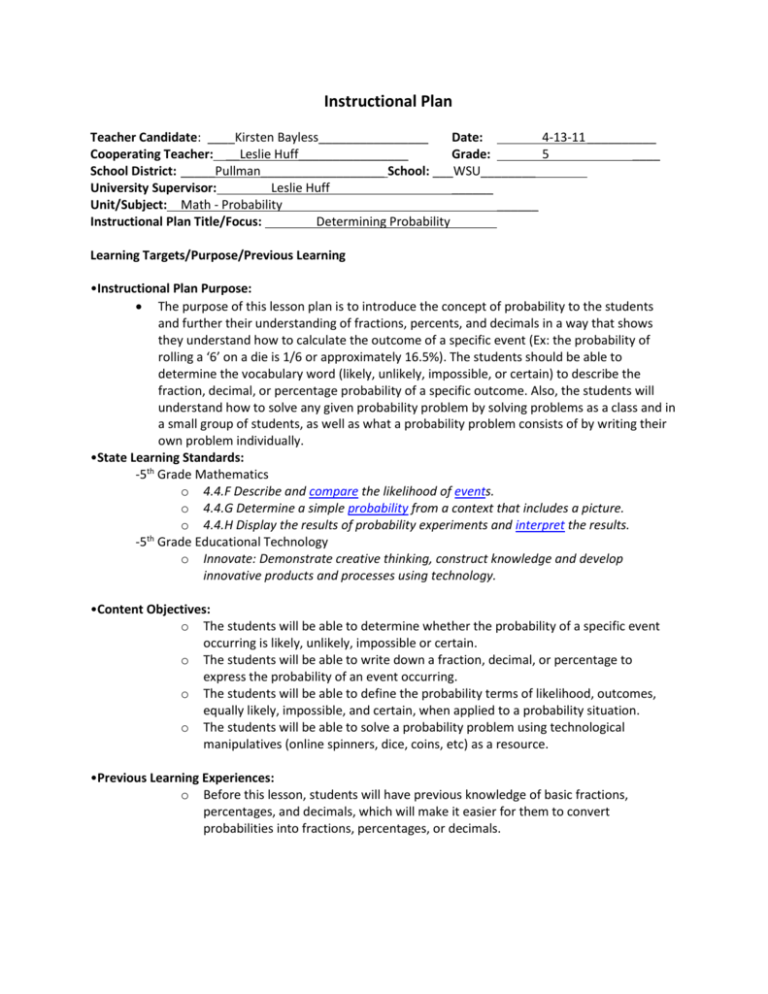
Instructional Plan Teacher Candidate: ____Kirsten Bayless________________ Date: 4-13-11 __________ Cooperating Teacher: __Leslie Huff________________ Grade: 5 ____ School District: _____Pullman__________________ School: ___WSU________ University Supervisor: Leslie Huff ______ Unit/Subject: Math - Probability ______ Instructional Plan Title/Focus: Determining Probability Learning Targets/Purpose/Previous Learning •Instructional Plan Purpose: The purpose of this lesson plan is to introduce the concept of probability to the students and further their understanding of fractions, percents, and decimals in a way that shows they understand how to calculate the outcome of a specific event (Ex: the probability of rolling a ‘6’ on a die is 1/6 or approximately 16.5%). The students should be able to determine the vocabulary word (likely, unlikely, impossible, or certain) to describe the fraction, decimal, or percentage probability of a specific outcome. Also, the students will understand how to solve any given probability problem by solving problems as a class and in a small group of students, as well as what a probability problem consists of by writing their own problem individually. •State Learning Standards: -5th Grade Mathematics o 4.4.F Describe and compare the likelihood of events. o 4.4.G Determine a simple probability from a context that includes a picture. o 4.4.H Display the results of probability experiments and interpret the results. -5th Grade Educational Technology o Innovate: Demonstrate creative thinking, construct knowledge and develop innovative products and processes using technology. •Content Objectives: o The students will be able to determine whether the probability of a specific event occurring is likely, unlikely, impossible or certain. o The students will be able to write down a fraction, decimal, or percentage to express the probability of an event occurring. o The students will be able to define the probability terms of likelihood, outcomes, equally likely, impossible, and certain, when applied to a probability situation. o The students will be able to solve a probability problem using technological manipulatives (online spinners, dice, coins, etc) as a resource. •Previous Learning Experiences: o Before this lesson, students will have previous knowledge of basic fractions, percentages, and decimals, which will make it easier for them to convert probabilities into fractions, percentages, or decimals. Assessment Strategies: Content Objectives The students will be able to determine whether the probability of a specific event occurring is likely, unlikely, impossible, or certain. Assessment Strategies Formative: Walk around and observe students solving probability problems (make a checklist of which students are correctly solving the problems and which students need extra help). The students will be able to write down a fraction, decimal, or percentage to express the probability of an event occurring. Summative: “Exit ticket” at end of class with several probability problems Formative: Use the student-created problems that the students solved to see if they have a proper fraction, decimal, or percentage written down for the answer to the problem. The students will be able to define the probability terms of likelihood, outcomes, equally likely, impossible, and certain, when applied to a probability situation. Summative: “Exit ticket” at end of class that allows students to write answers to several probability problems in fraction, decimal, or percentage format Formative: Walk around and ask each student the meaning of a probability term as they are working on their probability problems (make a checklist of which students get the correct answers). The students will be able to solve a probability problem using technological manipulatives (online spinners, dice, coins, etc) as a resource. Summative: “Exit ticket” at end of class where the students have to define the terms discussed in class Formative: Walk around and observe the students solving probability problems using the probability website with the online manipulatives shown at the start of the lesson. Student Voice: K-12 students will: 1. Communicate the learning targets and their progress toward them. Student-based evidence to be collected (things produced by students: journals, work samples, projects, papers, etc.) Student-written probability problem Description of how students will reflect on their learning Students will write their own probability problem showing that they understand what a probability problem consists of and they will solve another student’s problem to show that they know how to solve a 2. Review their performance and set personal learning goals based on those assessments. Reflection for homework problem and evaluate whether the problem was easy to solve or more difficult for them. Students will write a reflection describing what they had a difficulty with when solving probability problems, and what they still need to work on in order to understand the material better. Grouping of Students for Instruction Students’ desks will be arranged in groups of four spaced evenly throughout the classroom. If possible, at least one struggling student and one student who understands the material well or has background in probability will be at each group. Students will work on probability problems in groups of four during class instruction and discussion, then they will report to the whole class. Students will individually write their own probability problems and then pass them to a different group member to solve. Learning/Teaching Experiences Introduction: o Attention Grabber: “Imagine now with me that we are playing a game of Yahtzee. It is your turn to roll and you want to get a Yahtzee or a 5-of-a-kind. If you do not get a Yahtzee, you will have to take a zero for the category. Before you roll, it is important to know the risk that you are taking so that you can make the best decision possible. By the end of the class today, you will be able to figure out if it is a good idea to go for a Yahtzee or not by calculating the probability of getting a Yahtzee.” o Connection to Students’ Lives: “Probability is the possibility that a certain event will happen. For instance, in Yahtzee, the probability of getting a Yahtzee is all the possible rolls to get a Yahtzee out of how many possible rolls that could be a Yahtzee or not a Yahtzee. Probability is important when we are taking risks because we want to make the decision that gives us the best chance. People around the world use probability every day. The weather man uses it to let us know the possibility of snow occurring when he says, “There will be an 80% chance of snow today.” Knowing the probability of the weather can help us to plan the events of our day and know what to wear. In another sense, probability can be as simple as just knowing the possibility of pulling out a chocolate chip granola bar in a variety pack. All of these situations happen in our daily lives, so it is good to know how to calculate probability.” Questions: o 1. What are some examples of probability in real life when you would have to decide whether an event is likely to happen or not? o 2. How does what we have learned about fractions play into probability? o 3. Why is it important to know how to calculate probability? o 4. What are some other games (like Yahtzee) where calculating probability would give you an advantage? Why? o o 5. What are all the ways that you can calculate probability? Which one do you prefer and why? At the end of the lesson, I will pass out a different question to each table group and ask them to do a “think/pair/share” activity, meaning that they will write their answer independently in their journals, then they will share their answers with one other person in the group, and finally they will share their question and answers with the entire class. We will have a short class discussion about each question. Instruction: o Teaching Approaches: The teacher will teach the entire class how to solve a probability problem several different ways and explain the meaning of probability terms on the whiteboard or the smart board. The teacher will walk around and listen to group conversations about solving probability problems and the difficulties that they are having, and he/she will interfere and ask questions to probe new ways to the solution when they are needed. The teacher will use the discussion information and group conversations to come up with an “exit ticket” and make sure that students understand the material well. The teacher will have a group discussion asking the class about different ways to solve probability problems, when probability will come up in real life, and why probability is important, allowing the students to think critically. o Multiple means of access Students will get information at the start of the class from the teacher through an explanation of probability terms and a demonstration of several different ways of solving probability problems. Students will be provided with a vocabulary sheet of all of the probability terms that they need to know. Students will be given a chance to interact and discuss probability solutions with their groups, as well as with the entire class in group discussion. Students will be given time to explore the probability manipulatives through technology and hands-on physical manipulatives. o Multiple means of engagement Class discussion Teacher modeling Independent and group work Visual representation Technology (online manipulatives) o Multiple means of expression Students can create problem about anything as long as it includes the basic components of a probability problem (describes situation, in order to solve you must determine likelihood and give a numerical answer in fraction, decimal, or percentage form). Students can solve problems in a variety of different ways Using words, pictures, numbers Using manipulatives available in class Using technology (online manipulatives) Learning Activities: o Instructional Plan Students will learn how to calculate probability several different ways as a class through the teacher going through a couple problems step-by-step with the class. The teacher will show how to solve the probability problem using algebra, drawing pictures, using hands-on manipulatives, and using technological manipulatives (online spinner, dice, etc). The teacher will define the basic probability terms and hand out a vocabulary sheet with definitions for future reference. The students will be given the same probability problem to solve as a group, while the teacher walks around and listens to group conversations and asks the group questions to get them back on track if they do not understand how to solve the problem. The teacher will ask different groups to go up to the board and explain to the class how they solved the problem and why they chose to solve it that way. The teacher will tell the students that they now have the chance to write their own probability problem individually. The teacher emphasizes that each student must write their own problem and not write these problems as a group. The problems can be about any subject as long as they incorporate some of the vocabulary for probability that was learned and lead the student who is solving the problem to give an answer as a fraction, percent, or decimal, as well as a vocabulary term identifying the likelihood of the event in the problem. The teacher will tell the students to pass their probability problems to the student on their right, so that each student has a new probability problem to solve. The teacher gives the students some time to solve these probability problems while circulating the room and observing the different ways those students are solving the problems. If students are having difficulty, the teacher helps them by asking them a question to get them closer to the answer or showing them a different way they could think about the problem (pictures, algebra, symbols, etc). The teacher will collect the problems and solutions to assess the students’ knowledge of probability and whether they know how to solve the problems correctly or not. The teacher will have a closing discussion with the class, going back to the problem about Yahtzee at the beginning of class. The teacher asks several students to come up to the board and try to explain how to solve the problem to the class. The class has a final discussion about probability, as the teacher asks some of the critical thinking questions listed above (each table group does a Think/Pair/Share activity as described above). The class will fill out an “exit ticket” that the teacher created while the students were working on solving their own probability problems. The “exit ticket” will consist of defining several probability terms and solving a basic probability problem that has an answer of a probability expressed as a decimal, fraction, or percent. The class will write a reflection as homework, detailing what they learned about probability and what they struggled with the most. The teacher will collect these reflections the next day to gather information on whether to change the lesson o o plan, make an action plan, help individual students, or re-teach probability in a new way. Modes of Presenting Tasks: The teacher will use either a whiteboard or smart board to show the class how to solve a probability problem using algebra or pictures. The teacher will show various ways of solving the same probability problem using both hands-on manipulatives and the smart board to go to the technological manipulatives website, showing students that they can use technology to solve the problem. Natural Library of Virtual Manipulatives (http://nlvm.usu.edu/en/nav/category_g_2_t_5.html) Remedial and Extension Activities Remedial: Put the students into partner groups, pairing students who struggle understanding with students who are getting the concepts well. Have the students who understand well explain the process of how they solve a couple probability problems and allow the students to ask questions of one another to fully understand the process. If the student still does not understand, provide some extra worksheets or allow them some time inside class to play some probability games or activities online. Ex: http://www.free-training-tutorial.com/probability-games.html Extension: Have the students design their own board game that incorporates some aspect of probability. For instance, the game could have a die, a colored/numbered spinner, or different colored game spaces. Have them figure out the probability for a few specific outcomes of the game. Closure: o Students will be given one of the five critical thinking questions that are listed above. They will do a Think/Pair/Share activity, where they are given time to write down their response to the question, then they share those responses with their group, and last they share their group responses with the rest of the class. The teacher will have a closing discussion about probability, using the questions and responses to frame the discussion and then answer and discuss any other questions that students may have. Question 1: How would you use probability in a real life situation? Question 2: How do you prefer to solve a probability problem and why? The teacher will remind students about the Yahtzee problem at the beginning of the lesson and solve the problem with the class, asking several students to come up and show a way to solve the problem. The teacher will also remind students that probability situations come up in real life with games, the weather, and everyday decisions we make. Independent Practice: o Possible Family Interaction Have the students have a family game night and play dice games or board games that reflect the probability terms that were learned or a problem that may be solved (i.e. games that involve a colored spinner, dice, coins, etc) Additional Requirements Integration with Other Content Areas: o English is integrated into this lesson through the introduction of probability vocabulary terms, including highly likely, unlikely, impossible, certain, likelihood, outcomes and equally likely. Students are given a sheet with all of the vocabulary terms and definitions for their use. Acknowledgements: o Instructional plan adapted from http://teachingtoday.glencoe.com/lessonplans/probability-predicting-outcomes-andlikelihood o Instructional Plan created by Kirsten Bayless o Washington state standards for this lesson plan were taken from the OSPI website
